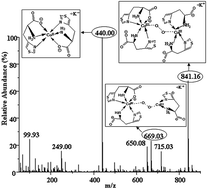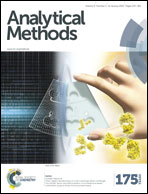Investigation of the structural characterization and reversible oxygenation mechanism of oxygenated cobalt–3-(4-thiazolyl)-l-alanine and cobalt–histidine complexes using electrospray tandem mass spectrometry
Abstract
The reversibility of dioxygen uptake by a complex is highly dependent on the stability of its superoxo- or dinuclear peroxo-intermediates. It is important to characterize oxygenated intermediates for the mechanistic investigation of reversible dioxygen uptake by complexes. Although the oxygenated complexes can be investigated by conventional techniques, the oxygenated species can only be identified indirectly. Thus new techniques for the direct differentiation of the oxygenated species are required to prove the existence of oxygenated species in complexes. In this paper, the electrospray mass spectrometry (ESI-MS) method was developed to directly identify oxygenated species. The newly reported cobalt–3-(4-thiazolyl)-L-alanine (Co–Tza) and the well-known cobalt–histidine (Co–His) complexes were used as targets. Fragmented ions of the dinuclear oxygenated complexes of Co–Tza and Co–His in aqueous samples were evident in ESI-MS spectra. The ESI mass spectra of Co–Tza and Co–His suggested the formation of dinuclear peroxo complexes, [CoIIIL2]2(O2), and the spectrum of Zn–His only showed the fragments of a mononuclear Zn(His)2 complex. The results also revealed that in the electrospray positive ion detection mode, the Co–Tza and Co–His complexes had similar fragmentation patterns, resulting likely from the similarities in the ligand structure and coordination modes between the complexes. The fragmented structures of sodium and potassium adducts of Co–Tza and Co–His were almost identical, indirectly confirming the rationality of the proposed fragmentation patterns. For comparison, theoretical modeling computations and volumetry were used to examine the oxygenation of Co–Tza. The results revealed that ESI-MS can be a useful and powerful technique for characterizing oxygenated complexes and investigating oxygenation mechanisms.


 Please wait while we load your content...
Please wait while we load your content...